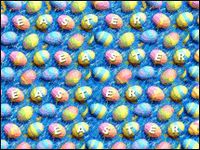
Eggs and rabbits - what does it all mean?

In a few days teachers and their students will have a well earned Easter break?
I know schools are busy teaching their planned units but Easter is a great ‘mini study’ to undertake, to learn the history and traditions behind Easter, and to make use of their information gathering and expressive skills.
I dislike seeing Easter reduced to making ‘corny’ Easter eggs but if teachers make use of a constructivist approach Easter ( and the eggs) can be the motivation for a powerful in- depth study and to demonstrate to them how they learn ( ‘construct’ knowledge).
Constructivism introduced before ‘Tomorrow’s Schools’ and was well known to teachers then as the 'Learning In Science Project' (LISP) but it was ‘overwhelmed’ having to face up to implementing the new standards based curriculums with all their endless strands and objectives. Thankfully even the Ministry has now seen that this was largely a waste of time and energy.
Constructivism places importance on making teachers skills central to helping students reflect on, challenge and clarify their own understandings, while at the same time building up their ‘learning power’. And it is an approach that, while the teachers can ‘imagine’ many of the children’s idea beforehand, all sorts of equally important ‘unplanned' ideas can also emerge. Constructivism is creative way of teaching! It is a means to let students control their own learning and builds on their natural desire to make meaning and need to express their ideas.
So back to Easter and all those eggs and rabbits!
First what are the student's ‘prior ideas ‘about Easter?
What does Easter mean to them?
Why do we have Easter Eggs and why are rabbits involved?
What has Jesus Christ got to do with it?
All these ‘prior ideas’ need to be valued and could well be recorded by individual students, or as a class, and written or displayed under a heading: ‘What we think we know about Easter: Our before views’.
An overall heading could focus the study: ‘Why do we celebrate Easter?’
Student's questions could also be displayed. One educationist calls then ‘fertile question’, another calls them ‘key’ questions – but whatever do not have too many.
Often the most important questions will emerge as the students start to dig into the deeper meanings of the symbols of Easter. Such things as the importance of religion, myths, legends and use of symbols; how cultures merge and absorb ideas from each other; and the perplexing differences in seasons between the Northern and Southern hemispheres which can lead into scientific thinking.
Answering these questions becomes the real work of the study. Students can get answers from home, by selectively using the internet, and the classroom teacher can also gather up information to share (and to ‘flesh out’ his or her own knowledge).
As it will only be ‘mini’ unit, recording might well be done by the class, or different students could divide up tasks to add to the total display.
And of course students could draw various aspects to add to the display and even make decorated Easter Eggs.
After the Easter break is over it would interesting to get the students to write or discuss what they now know about Easter, eggs and rabbits. This would a natural assessment task.
As well the teacher could discuss the constructive learning process they have just used – this is the process, if their curiosity is kept alive, that will be with them forever.
‘What we now know’ could be displayed to complete the unit.
I hope you all enjoy your Easter break and that it is a safe and a happy time.
Bruce
Educationalist David Ausabel wrote in the 60s ‘Find out what students already know and then teach accordingly’ Good advice. More quotes on our site
1 comment:
Good ideas - will get onto it right away!
Thanks
Post a Comment